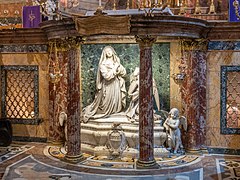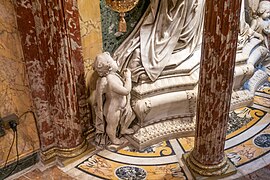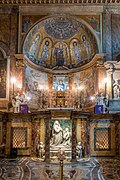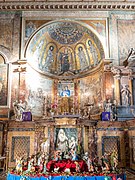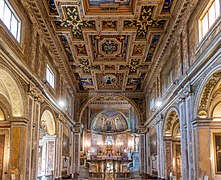| Confessio of Santa Francesca Romana | |
|---|---|
 | |
| Artist | Gian Lorenzo Bernini |
| Year | 1638–49 (1638–49) |
| Type | Sculpture |
| Medium | Marble |
| Subject | Frances of Rome |
| Location | Santa Francesca Romana, Rome |
| Coordinates | 41°53′28.21″N 12°29′19.87″E / 41.8911694°N 12.4888528°E / 41.8911694; 12.4888528 |
| Preceded by | Memorial to Maria Raggi |
| Followed by | Raimondi Chapel |
The confessio of Santa Francesca Romana is the confessio, the enclosed area below the altar, of the Basilica of Santa Francesca Romana in Rome.
It was built between 1638 and 1649 to a design by Gian Lorenzo Bernini, including a bronze sculptural group of St Frances and the angel. Bernini's sculpture was taken during the French occupation in 1798 and is now lost.
The current marble sculpture was created in 1866 by Giosuè Meli.
Description
The confessio is flanked by two tiers of steps. The curvilinear marble balustrade is decorated with marble drums. In the center of the balustrade is a two-door bronze gate decorated with leaf volutes and polychrome enamel roundels.
Inside the confessio is the sculptural group depicting St Frances and the angel, behind four columns of Sicilian red jasper.
St Frances and the angel

Bernini's sculptural group of St Frances and the angel was taken during the French occupation in 1798 and is now lost.
The current marble sculpture was created in 1866 by the Bergamo sculptor Giosuè Meli in the Neoclassical style. Meli sculpted extensive detail on the angel's robes.
History
The confessio was built between 1638 and 1649 to a design by Gian Lorenzo Bernini.
During the French occupation in 1798, Bernini's sculptural group of St Frances and the angel was taken and is now lost.
In 1866, the confessio was restored by the Oblate Maria Gertrude Pallavicini. Giosuè Meli created a marble sculpture to replace the lost Bernini one.
Gallery
See also
References
- Notes
- "altare di Bernini"
- "balaustrata di Bernini"
- "altare di Bernini"
- "S. Francesca Romana e l' Angelo"
- "S. Francesca Romana e l' Angelo"
- "altare di Bernini"
- "S. Francesca Romana e l' Angelo"
- "altare di Bernini"
- Bibliography
- "altare di Bernini Gian Lorenzo (sec. XVII)". Catalogo generale dei Beni Culturali. 2006. Retrieved 2023-04-23.
fiancheggiato da due gradinate, è costituito da una balaustra marmorea a r occhi con al centro un cancello di bronzo decorato a volute fogliacee. All 'interno è la mensa d'altare ed il gruppo scultoreo raffigurante Santa Fra ncesca Romana e l'Angelo. L'altare della Confessione fu eseguito tra il 1638 e il 1649 su progetto d i Gian Lorenzo bernini. Fu in seguito restaurato, come attesta l'iscrizion e, nel 1866 durante il pontificato di Papa Pio IX per disposizione testame ntaria dell'Oblata Maria Gertrude Pallavicini. PIO IX PONTEFICE MAXIMO AN MDCCCLXVI/ PRO AENEO MONVMENTO ASPERITATE TEMPO RVM PESVMDATO/ MARMOREVM CONSTITVIT/ MARIA GERTRVDE PALLAVICINA VIRGO E CO ENOBIO AD TVRR SPECVL/ PIETATIS STVDIO ERGA MATREM SVAM LEGIFERAM
- "balaustrata di Bernini Gian Lorenzo (sec. XIX)". Catalogo generale dei Beni Culturali. 2006. Retrieved 2023-04-23.
balaustra curvilinea decorata a rocchi di marmo con al centro un cancello a due ante in metallo dorato decorato con tondi in smalto policromo. La balaustra, come tutto il complesso dell'altare della confessione fu ese guita come attesta l'iscrizione nel 1866 seguendo l'antico progetto di Gian Lorenzo Bernini del 1638
- "S. Francesca Romana e l' Angelo". Catalogo generale dei Beni Culturali. 2006. Retrieved 2023-04-23.
L'opera come attesta l'iscrizione fu commissionata da Maria Gertrude Pallavicini durante il pontificato del papa Pio IX nel 1866. Fu eseguita dallo scultore bergamasco Giosuè Meli, allievo del Thordwaldsen e del Tenerani, i cui elementi stilistici ancora di gusto neoclassico sono evidenti nel gr uppo scultoreo. L'opera sostituisce quella eseguita da Gian Lorenzo Bernini nel 1638 che f u portata via nel 1798 durante l'occupazione francese; in quella occasione venne fusa l'urna di bronzo facente parte del gruppo scultoreo
External links
 Media related to Confessio (Santa Francesca Romana) at Wikimedia Commons
Media related to Confessio (Santa Francesca Romana) at Wikimedia Commons

